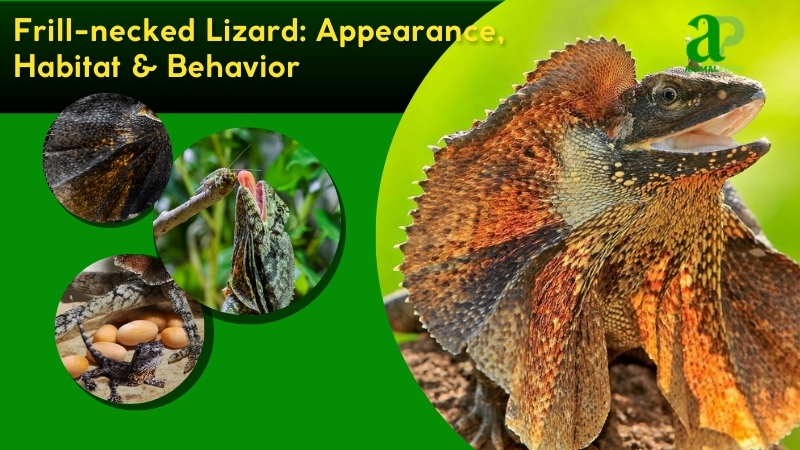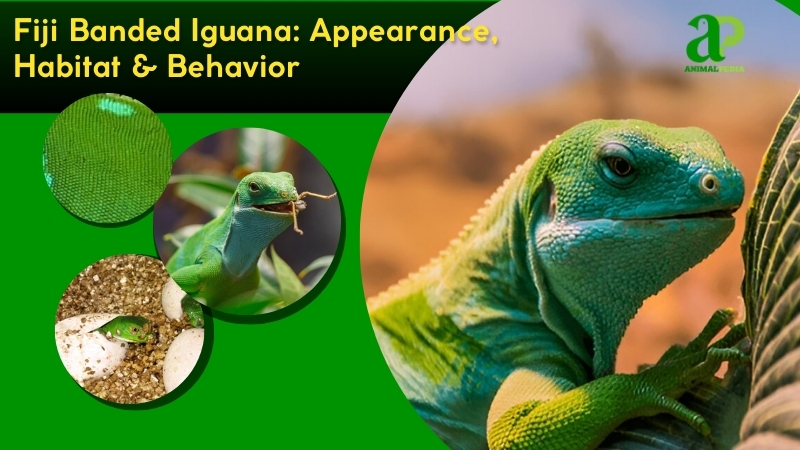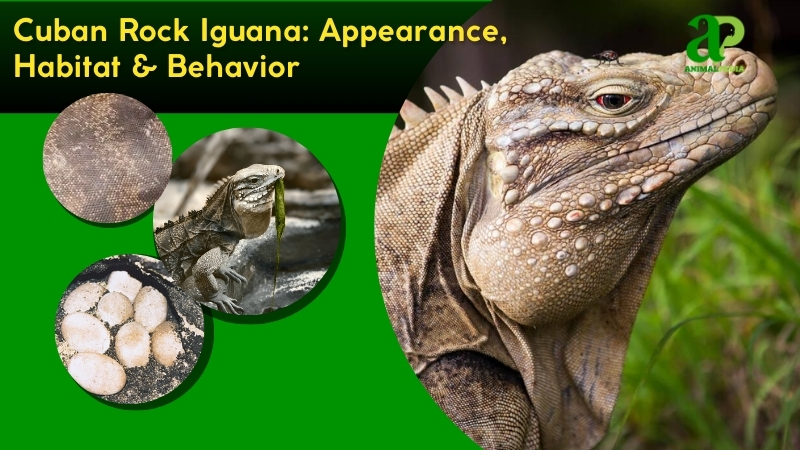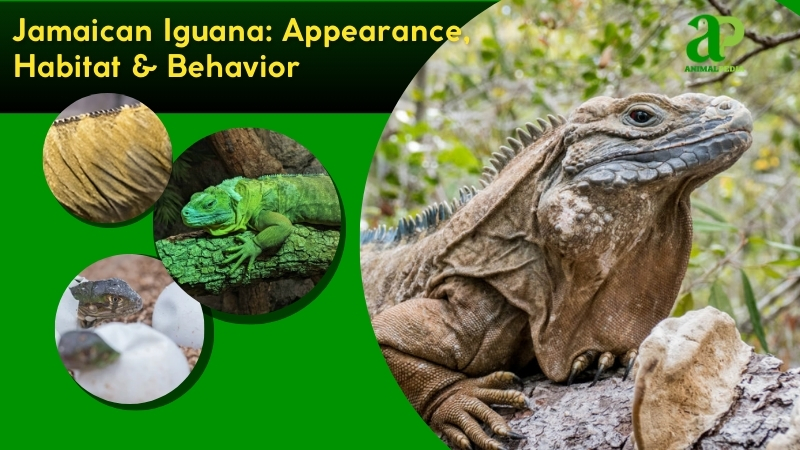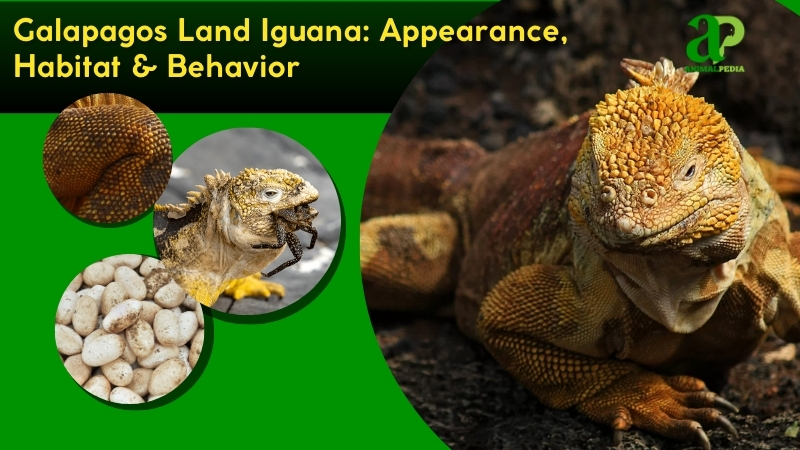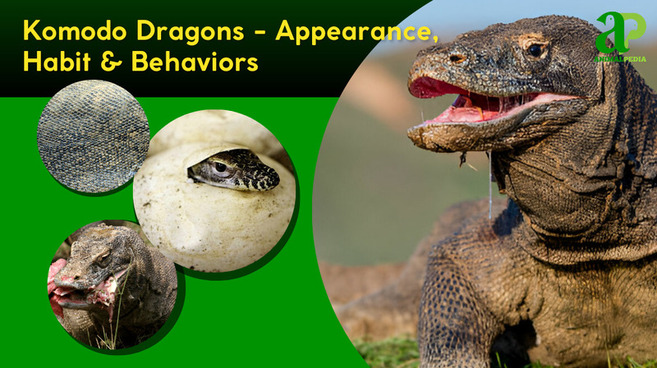Green iguanas are striking arboreal reptiles, showcasing vivid green skin, long whip-like tails, and prominent throat dewlaps. Only one Green iguana species exists: Iguana iguana, widely recognized for its adaptability across diverse tropical environments.
The scientific name Iguana iguana corresponds to its common name, Green Iguana, a species celebrated for its vibrant coloration and ecological significance in forested ecosystems.
They measure 4–6 feet (1.2–1.8 meters) in length, weigh 8–17 pounds (3.6–7.7 kilograms), and are distributed from southern Mexico through Central and South America, including Caribbean islands like Puerto Rico, Grenada, and Curaçao. Their dewlap, a large throat flap, is a distinctive feature used for thermoregulation and communication.
Green iguanas are herbivorous, not apex predators, feeding on leaves, fruits, and flowers high in forest canopies. They expertly climb to forage, avoiding predators like hawks, and are wary of humans, though they may bite or whip their tails if threatened. The green iguana diet promotes seed dispersal, aiding tropical forest regeneration.
Mating occurs in October–November, with females laying 20–70 eggs in burrows during February–March. Eggs incubate for 10–12 weeks, producing 8–10-inch (20–25 centimeter) hatchlings that consume soft foliage. Juveniles mature in 3–4 years, with lifespans of 10–15 years in the wild.
This article examines their vivid appearance, lush tropical habitats, and adaptive behaviors. Green iguanas embody resilience in dynamic ecosystems.
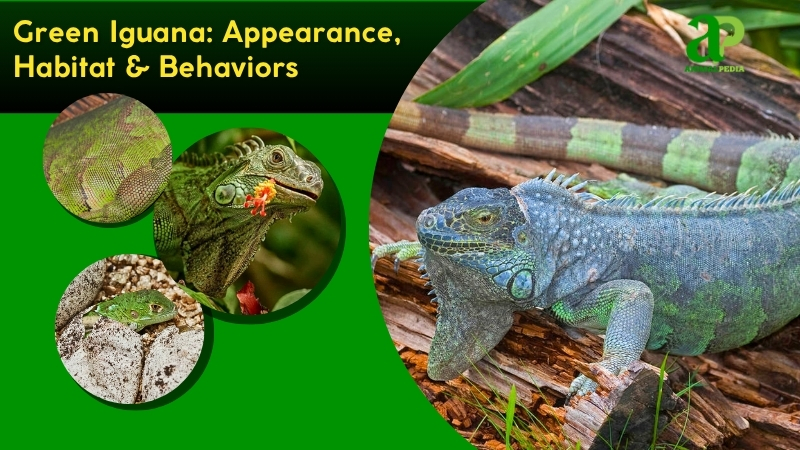
What do the Green Iguana look like?
Green iguanas possess sleek, elongated bodies with vibrant green skin, ranging from vivid emerald to muted olive, often accented by faint dark bands on the tail. Their scales are smooth and overlapping, creating a glossy texture that facilitates swift arboreal movement in tropical forests. They span 4–6 feet (1.2–1.8 meters) in length and weigh 8–17 pounds (3.6–7.7 kilograms), with males typically larger.
The head is broad and triangular, featuring large, round eyes with excellent vision for detecting predators. A forked tongue aids in chemosensory exploration. A distinctive dewlap, a fleshy throat flap, extends from the neck for thermoregulation and signaling. The body is lithe yet muscular, supported by four strong limbs equipped with sharp, curved claws that enable gripping of branches. The tail, 2–4 feet (0.6–1.2 meters), is whip-like, used for balance and defense.
Unlike rhinoceros iguanas (Cyclura cornuta), which have rough, horned snouts, green iguanas boast smoother, brighter skin and lack nasal protrusions, making them visually distinct within the Iguanidae family, according to Burghardt et al. (2019).
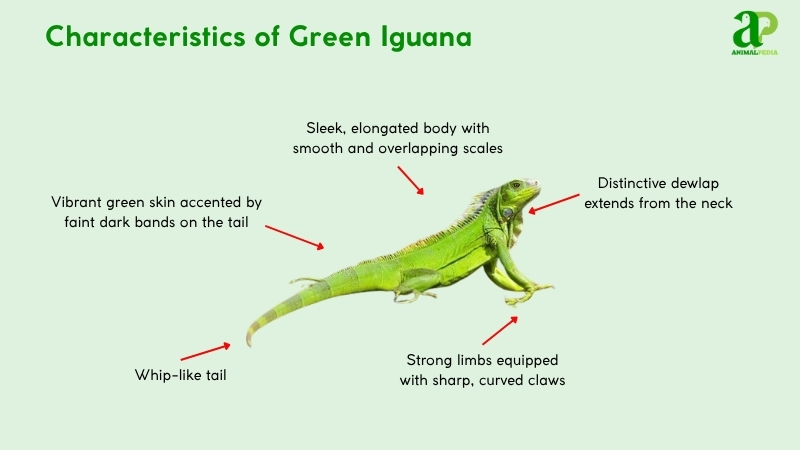
How big do Green Iguana get?
The Green Iguana’s size is about 4–6 feet (1.2–1.8 meters) in length and weighs 8–17 pounds (3.6–7.7 kilograms). Their slender build suits arboreal life.
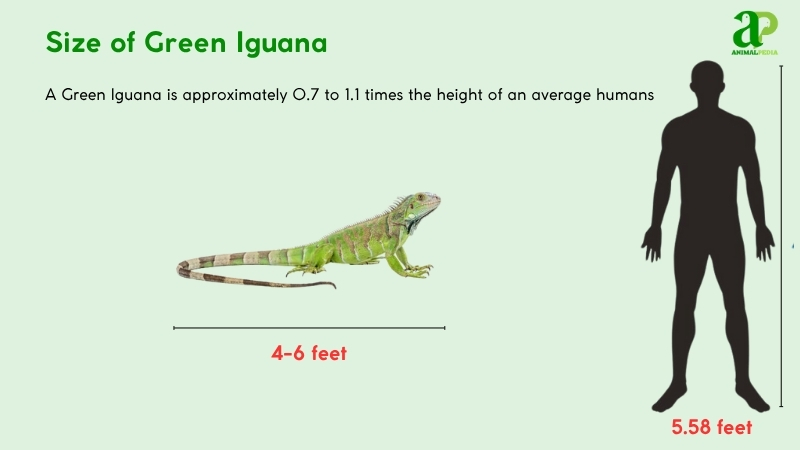
The biggest Green iguana ever recorded, a male from Costa Rica in 2018, reached 6.6 feet (2 meters) and weighed 20 pounds (9 kilograms), per Burghardt et al. (2019).
Adults typically measure 5–6 feet (1.5–1.8 meters) from snout to tail. Males are larger, averaging 5.5–6 feet (1.7–1.8 meters) and 12–17 pounds (5.4–7.7 kilograms), while females average 4.5–5 feet (1.4–1.5 meters) and 8–12 pounds (3.6–5.4 kilograms). Sexual dimorphism supports male dominance in mating.
| Trait | Male | Female |
| Length | 5.5–6 ft (1.7–1.8 m) | 4.5–5 ft (1.4–1.5 m) |
| Weight | 12–17 lb (5.4–7.7 kg) | 8–12 lb (3.6–5.4 kg) |
What are the unique physical characteristics of the Green Iguana?
Green iguanas are distinguished by their large, extensible dewlap and vibrant green coloration, traits not found in other iguana species like Cyclura cornuta. These features enhance their arboreal lifestyle and social interactions.
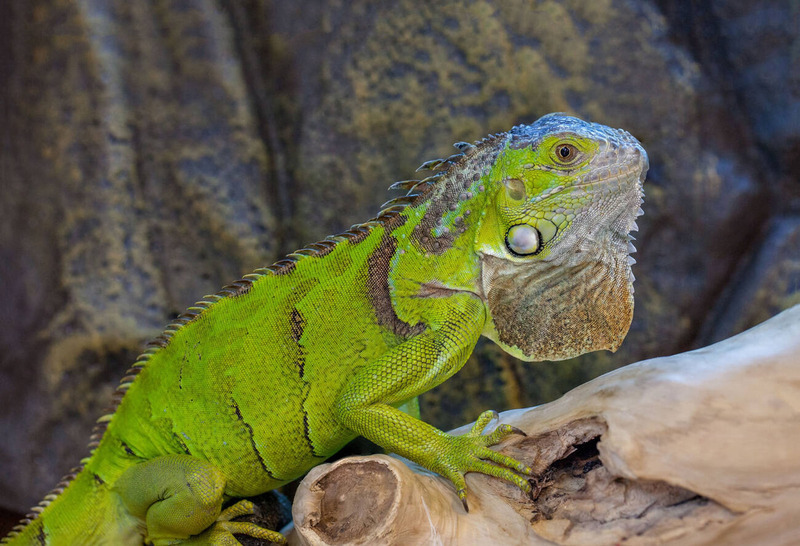
The dewlap, a fleshy throat flap, spans up to 12 inches (30 centimeters) in males and aids in thermoregulation and courtship displays, per Burghardt et al. (2019). Their skin, with tightly packed, smooth scales, shifts from emerald to olive, providing camouflage in forest canopies.
This coloration, driven by chromatophores, is unique among Iguanidae, enabling rapid color changes for signaling or stress response. These adaptations support survival in predator-rich tropical environments.
How do Green Iguana adapt with its unique features?
Green iguanas use their dewlap and vibrant coloration to thrive in tropical forests. The dewlap regulates body temperature and signals mates, while green skin provides camouflage, per Burghardt et al. (2019).
Keen vision detects predators, enhancing survival, and a sensitive tongue senses chemical cues, optimizing foraging. Their strong limbs and sharp claws enable agile climbing in dense canopies, accessing sunlit feeding areas. A whip-like tail aids balance and serves as a defensive weapon against predators.
Additionally, lungs with high oxygen efficiency support arboreal activity, while lateral body compression aids branch maneuvering. Juveniles mimic leaf patterns for concealment. These adaptations ensure green iguanas efficiently evade threats and exploit vertical forest layers in predator-rich, resource-dense habitats.
The Green Iguana is a master of the The Green Iguana is a master of the rainforest. But to see how its relatives conquered the desert, you need to meet the incredible Desert Iguana.
Anatomy
Green iguanas have specialized anatomical systems tailored for their arboreal, herbivorous lifestyle in tropical forests. These systems enhance survival in predator-rich, resource-variable environments, per Burghardt et al. (2019).
- Respiratory System: Efficient lungs support prolonged climbing. This aids thermoregulation in humid climates.
- Circulatory System: The three-chambered heart sustains low-energy metabolism. It supports endurance in foraging.
- Digestive System: Long intestines ferment fibrous plants. Sharp teeth shred leaves efficiently.
- Excretory System: The kidneys conserve water by expelling uric acid. This adapts to variable water availability.
- Nervous System: Keen vision and olfaction detect threats. The brain coordinates rapid escape responses.
These systems enable green iguanas to exploit canopy resources, evade predators, and maintain hydration. Their anatomy reflects evolutionary adaptations for thriving in dynamic, tropical ecosystems with high predation and competition.
While this anatomy was perfected for the mainland tropics, evolution forged an entirely different masterpiece for a single volcano: the Galapagos Pink Land Iguana
How many types of Green Iguana?
The Green Iguana (Iguana iguana) is a single species with two recognized subspecies: Iguana iguana iguana (nominate subspecies) and Iguana iguana rhinolopha. These subspecies differ slightly in morphology and geographic range.
The classification is based on morphological traits and geographic variation, supported by molecular data. Köhler et al. (2019) emphasized these distinctions using DNA barcoding and morphometric analysis.
Taxonomy is built upon the Linnaean hierarchy and refined through phylogenetic analysis by herpetologists. The foundational classification places the Green Iguana in the family Iguanidae, genus Iguana, and species iguana.
Order: Squamata
└── Family: Iguanidae
└── Genus: Iguana
└── Species: Iguana iguana
├── Subspecies: I. i. iguana
└── Subspecies: I. i. rhinolopha
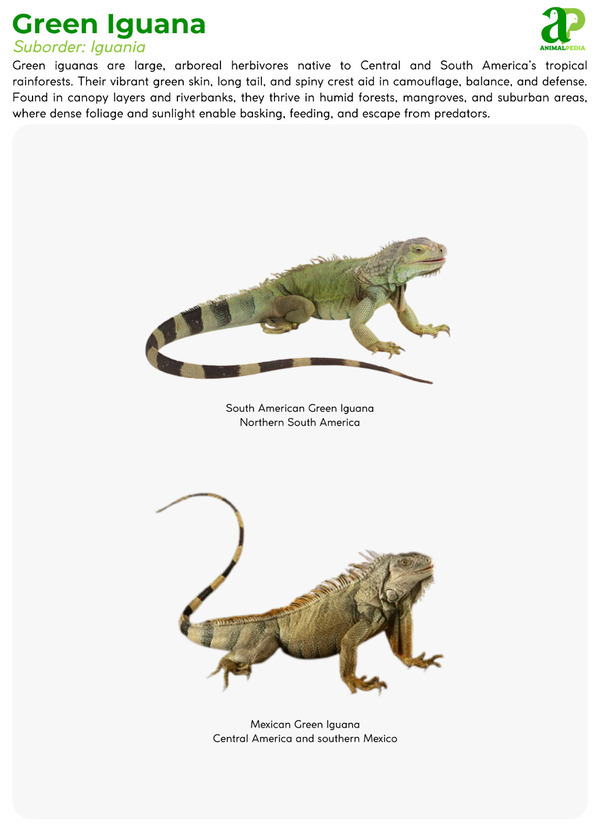
While Iguana delicatissima (Lesser Antillean Iguana) belongs to the same genus, it is a separate species and not a type of Green Iguana. Some hybrid zones have been reported, especially where I. The iguana has been introduced outside its native range, complicating taxonomy.
Where do Green Iguanas live?
Green iguana habitats are distributed from southern Mexico to central Brazil, concentrated in Costa Rica’s rainforests, Colombia’s Orinoco Basin, and Caribbean islands like Puerto Rico and Grenada.
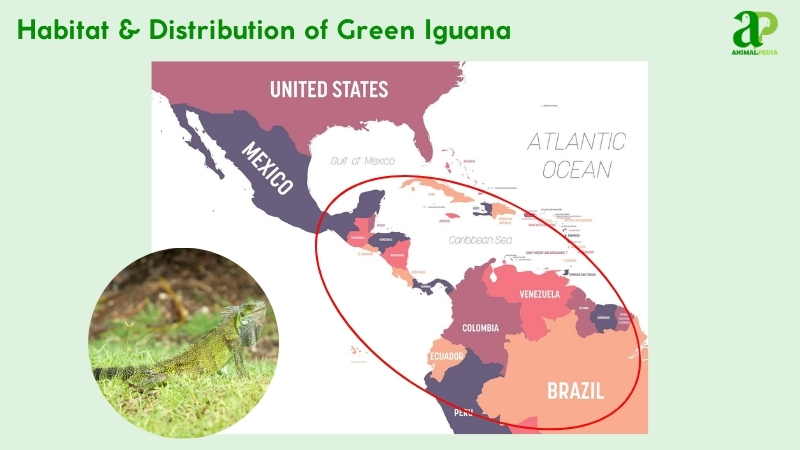
They thrive in humid tropical forests and riverine edges with temperatures of 77–95°F (25–35°C). Dense canopies and abundant foliage provide food and cover, which is ideal for their arboreal, herbivorous lifestyle, as per Burghardt et al. (2019). These conditions support climbing and thermoregulation.
Fossil records indicate their presence in these regions for millions of years. No migration occurs; they in stable habitats. Their distribution reflects adaptations to lush, predator-rich environments.
How do seasonal changes affect their behavior?
Green iguanas (Iguana iguana) exhibit seasonal behavioral shifts that correspond to the tropical climates in which they reside. These behavioral adaptations, largely influenced by rainfall and ambient temperature, play a critical role in maximizing survival and reproductive efficiency throughout the year.
- Wet Season (May–October): Abundant foliage boosts foraging; iguanas mate and lay eggs. Males display aggressive courtship behaviors.
- Dry Season (November–April): Reduced food limits activity; iguanas bask more to conserve energy. Mating and nesting decline.
By modulating their behavior with seasonal cues, green iguanas maintain energy balance, avoid resource stress, and time reproduction for optimal offspring survival. This cyclical pattern is vital for their persistence in fluctuating tropical ecosystems.
What is the behavior of the Green Iguana?
Green iguanas (Iguana iguana) exhibit a complex set of behaviors finely adapted to their arboreal lifestyle in tropical forests. Their daily routines, feeding patterns, and social interactions reflect evolutionary responses to dense canopies, seasonal resource availability, and predation pressures.
- Feeding Habits: They consume leaves, fruits, and flowers. Sharp teeth shred fibrous plants.
- Bite & Venomous: Non-venomous, they bite defensively. Bites cause minor wounds.
- Daily Routines and Movements: Diurnal, they bask and forage, moving 0.6–1.2 miles (1–2 km). Activity peaks in the mornings.
- Locomotion: Agile climbers use claws for canopy navigation. Tails aid balance.
- Social Structures: Solitary, males defend territories. Females share nesting sites.
- Communication: Dewlap displays and head-bobbing signal dominance. Pheromones mark territories.
Collectively, these behaviors make green iguanas vital to their ecosystems. Their role in seed dispersal and forest regeneration underscores their ecological importance, highlighting the need for continued behavioral and conservation-focused research.
What do Green Iguana eat?
As herbivores, the Green Iguana’s diet consists of leaves, fruits, and flowers, with a preference for Ficus leaves and hibiscus blossoms. They do not eat meat or attack humans, per Burghardt et al. (2019). They chew foliage with sharp teeth, and oversized food may cause choking.
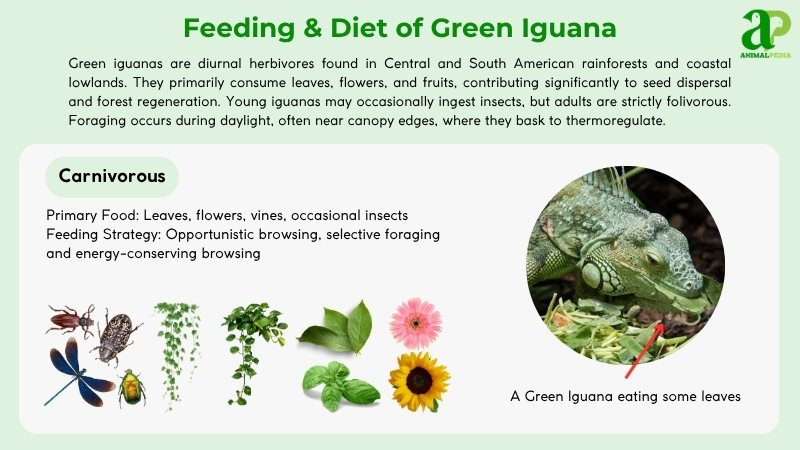
- Diet by Age:
The diet of green iguanas shifts as they grow, aligning with their jaw strength and digestive capacity. Hatchlings primarily consume soft leaves, tender flowers, and young shoots, which are easier to process. As juveniles mature, their diet diversifies to include fleshy fruits and broader leaf types. Adults, with fully developed jaw muscles and dentition, can consume fibrous, coarse foliage, woody vines, and mature leaves high in cellulose.
- Diet by Gender:
While the Green iguana diet is similar between males and females—dominated by leaves, fruits, and flowers—females may exhibit selective feeding during reproductive periods. In preparation for egg production, they seek out calcium-rich vegetation, such as certain legumes or mineral-dense leaves, to aid in shell formation and ensure embryonic development.
- Diet by Seasons:
Seasonal variation in tropical environments influences feeding behavior. During the wet season (May–October), increased rainfall triggers fruiting and leaf growth, promoting frequent feeding. In the dry season (November–April), food scarcity leads to reliance on evergreen foliage, with reduced intake to conserve water and metabolic energy.
How do Green Iguana hunt their prey?
Green Iguanas mostly eat plants but occasionally hunt for small insects, snails, and bird eggs. They’ve excellent eyesight to spot movement and track their prey. When hunting, they rely on their speed and agility to catch their target using their strong jaws and sharp teeth.
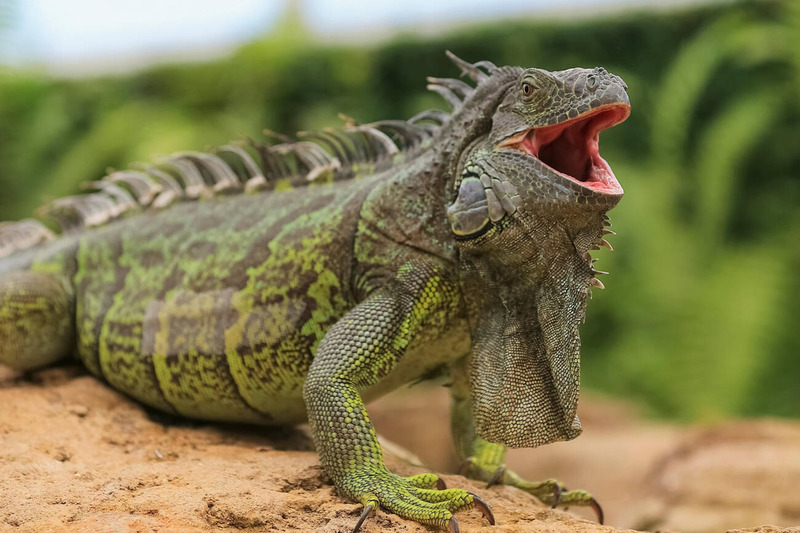
Though they prefer plants, their hunting skills show how adaptable and resourceful they are. Watching a Green Iguana stalk its prey is an impressive sight that highlights their versatile nature.
Are Green Iguanas venomous?
To clear up any confusion, Green Iguanas aren’t venomous. Despite their sharp teeth and spiky appearance, their primary defense mechanism is their tail. When feeling threatened, a Green Iguana can swiftly whip its tail to deter predators or perceived threats.
While this movement can deliver a powerful blow, it’s crucial to note that their bite or scratches don’t contain venom.
These creatures rely on their agility and speed rather than venom to thrive in their natural environment.
You can admire Green Iguanas for their stunning coloration, graceful movements, and intriguing behaviors without concerns about venomous traits. Remember to respect these creatures from a safe distance and enjoy their beauty in the wild!
When are Green Iguanas most active during the day?
Green Iguanas are most active during the early morning and late afternoon hours when they can be seen basking in the sun to warm up their bodies. By soaking in the sun’s rays, they regulate their body temperature for daily activities like foraging for food and exploring their environment.
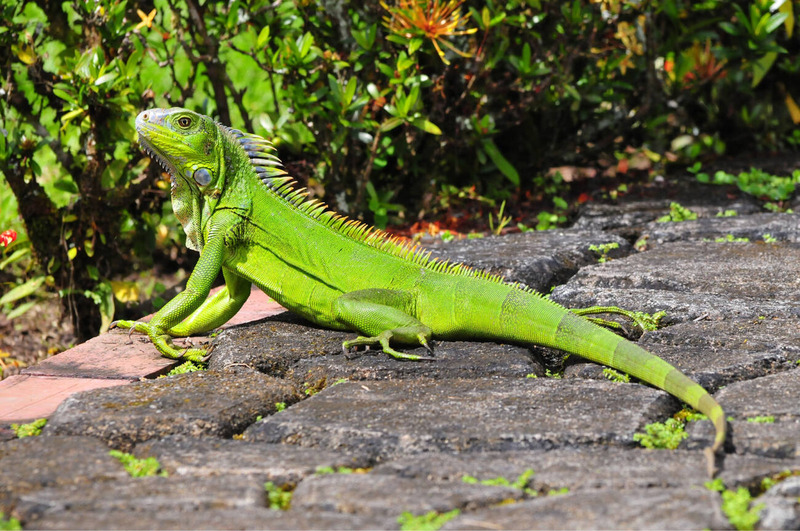
It’s essential for them to catch the morning sun to kickstart their day and to secure their warmth before nightfall in the late afternoon. This pattern of behavior helps them avoid the intense midday heat, making it easier for observers to spot these fascinating reptiles in action during the cooler parts of the day.
How do Green Iguanas move on land and water?
Green Iguanas have a fascinating way of moving both on land and in water. On land, these colorful reptiles are skilled climbers, using their strong legs and sharp claws to navigate their leafy habitats with agility and grace. Known for their adeptness in tree-dwelling, they can effortlessly jump between branches and climb up trunks with ease.
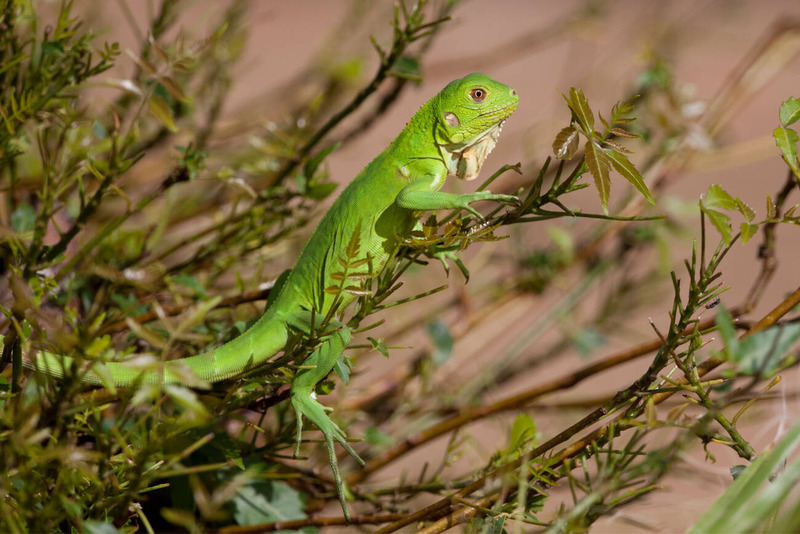
In water, the Green Iguana is a surprisingly strong swimmer, using its long tail to propel itself. This ability, however, is mostly used for travel or to escape predators. This is a key difference from their famous evolutionary relative, the Galapagos Marine Iguana, which is the only lizard in the world that dives to find food.
Whether traversing land or navigating through water, Green Iguanas exhibit a sense of freedom and confidence that captivates observers. Their ability to thrive in various terrains highlights their nature as captivating reptiles, truly illustrating their prowess in the animal kingdom.
Do Green Iguanas live alone or in groups?
Green Iguanas typically live alone and are known for their independent nature. They prefer solitary living, marking and defending their territory without forming social groups. These reptiles enjoy basking in the sun and hunting for food by themselves, showing a strong sense of freedom in their behavior.
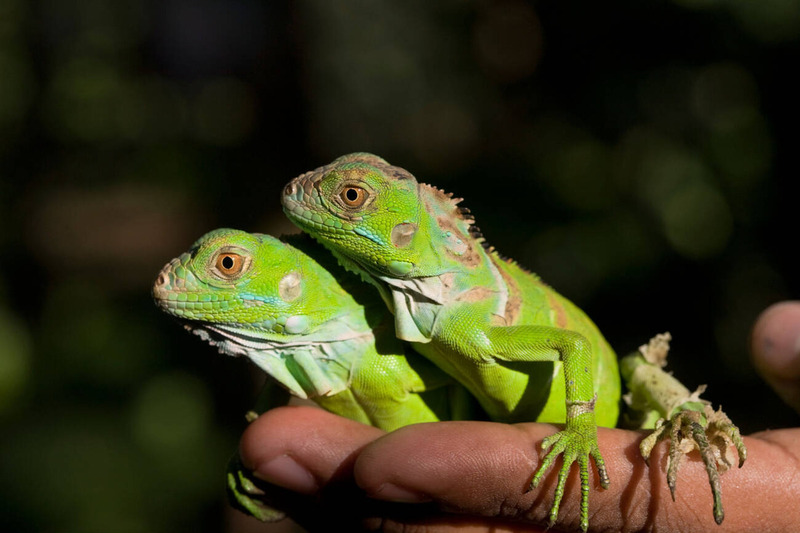
Their solitary lifestyle allows them to thrive in their lush habitats without the need for companionship from other iguanas. This independence enables them to make decisions and move around freely without the constraints of group dynamics.
If you value autonomy and independence, you might find the solitary lifestyle of Green Iguanas intriguing. Keep reading to discover more about how these fascinating creatures communicate in the wild.
How do Green Iguanas communicate with each other?
Green Iguanas communicate mainly through body language and visual signals. To assert dominance or claim territory, they puff up their dewlaps and bob their heads energetically, signaling ownership.
On the other hand, when they want to show submission, they lower their bodies and heads, sometimes concealing their dewlaps. When feeling threatened, these iguanas may hiss or thrash their tails to warn off potential predators.
Changes in their coloration, such as darkening, can indicate emotions like stress or aggression. Additionally, Green Iguanas use scent markings to communicate with others in their environment.
Through these non-verbal cues and visual displays, Green Iguanas effectively express their intentions and emotions within their community, ensuring clear communication.
How do Green Iguana reproduce?
Green iguanas reproduce oviparously, laying eggs in burrows. Breeding starts in October–November, with males displaying vibrant colors and head-bobbing to attract females. Females signal receptivity through subtle postures, and copulation lasts minutes, per Burghardt et al. (2019).
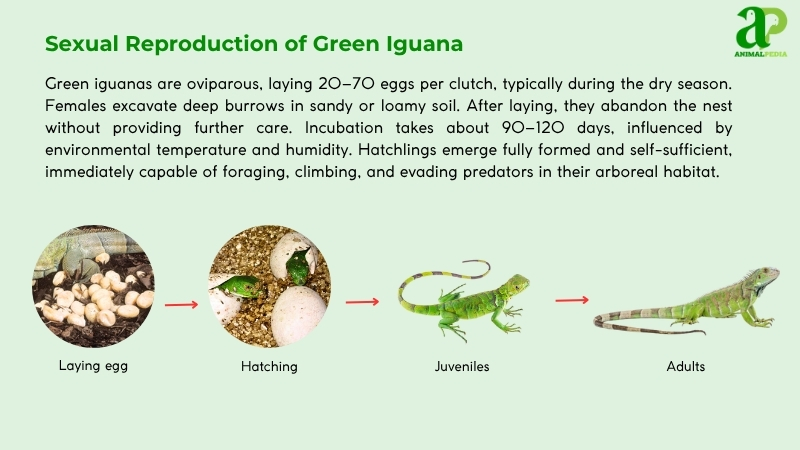
Post-mating, females lay 20–70 eggs in February–March, each weighing 1–1.5 ounces (30–45 grams). They dig burrows in sandy soil to store eggs, covering them to deter predators. No parental care occurs; males and females resume solitary foraging. Habitat disruption, like deforestation in Costa Rica in 2017, can reduce nesting success by 25%.
Eggs incubate for 10–12 weeks, hatching in April–May. Hatchlings, 8–10 inches (20–25 centimeters), eat soft leaves and grow rapidly, reaching maturity in 3–4 years. The green iguana’s lifespan is 10–15 years. High predation by birds and snakes threatens hatchlings, but their fecundity supports population resilience.
How long do Green Iguanas live?
Green iguanas have an average lifespan of 10 to 15 years in the wild; however, though in captivity, their lifespan may be prolonged up to 20 years. Life expectancy is influenced by habitat quality, predation, and access to food. Captive iguanas benefit from veterinary care and stable conditions, often leading to increased longevity.
There is no significant difference in Green iguana lifespan between males and females, although larger males may face more physical stress during territorial conflicts. Juvenile mortality rates are high in the wild due to predation and environmental threats (Burghardt et al., 2019).
What are the threats or predators that Green Iguana face today?
Green iguanas face multiple threats that jeopardize their populations across Central and South America. These pressures, combined with natural predation, challenge their survival in tropical habitats.
- Habitat Loss: Deforestation for agriculture has destroyed 20% of rainforest habitats since 2010, reducing canopy cover for foraging and nesting (Burghardt et al., 2019).
- Invasive Species: Feral cats and dogs kill 30% of hatchlings in urban areas, disrupting population growth.
- Illegal Pet Trade: Annual poaching of 10,000 iguanas for exotic markets depletes wild stocks, especially in Colombia.
- Climate Change: Rising temperatures alter rainfall, cutting food availability by 15%, impacting juvenile survival.
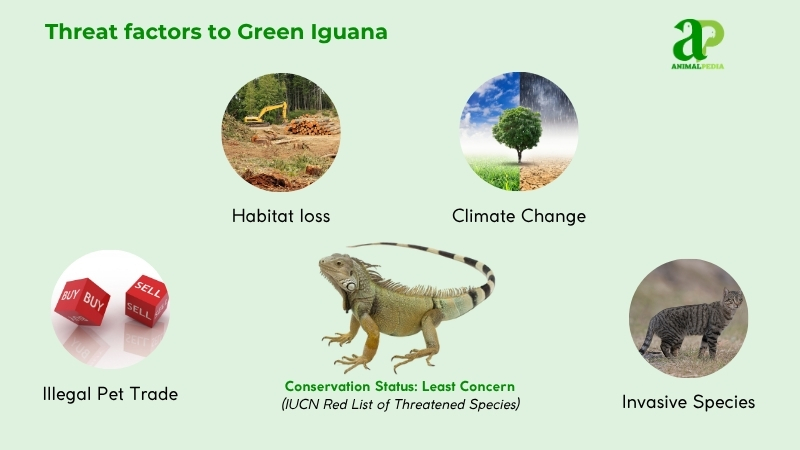
Green iguana predators include hawks, owls, and snakes, which target hatchlings and juveniles. Adults face fewer threats due to size, but dogs and cats pose risks in human-altered areas.
Human impacts are significant, with urbanization in Costa Rica fragmenting 25% of habitats since 2015, per Burghardt et al. (2019). Illegal hunting for food in rural Brazil and the pet trade in Puerto Rico further reduce populations by 10% annually. Conservation efforts aim to mitigate these threats through habitat protection.
Are Green Iguanas endangered?
Green iguanas are not endangered. The International Union for Conservation of Nature (IUCN) classifies Iguana iguana as “Least Concern” due to its wide distribution and stable populations across Central and South America, despite localized threats.
Population estimates indicate over 1 million mature individuals, with dense concentrations in Costa Rica (100,000–150,000), Colombia’s Orinoco Basin (200,000), and Puerto Rico (50,000), per Burghardt et al. (2019). Declines of 10–15% occur in urbanized areas like Panama due to habitat loss from deforestation, which has reduced 20% of rainforest cover since 2010.
The illegal pet trade removes approximately 10,000 iguanas annually, notably in Brazil, but high reproductive rates offset these losses. Invasive predators, such as feral cats, cause 30% hatchling mortality in some regions, yet overall numbers robust. Conservation measures, including habitat protection in national parks, support population stability.
What conservation efforts are underway?
Green iguanas face threats from habitat loss and the pet trade, prompting targeted conservation efforts. Since 2016, the International Iguana Foundation has led habitat restoration and headstarting programs in Costa Rica’s Gandoca-Manzanillo Refuge, releasing 500 iguanas by 2023.
The Convention on International Trade in Endangered Species (CITES) Appendix II regulates green iguana trade, requiring permits to curb poaching. In Florida, the Fish and Wildlife Conservation Commission (FWC) banned breeding and sales in 2021, with full restrictions by 2024, prohibiting unauthorized possession to control invasive populations.
The Iguana Verde project in Costa Rica, active since 2018, breeds and releases iguanas, with 200 juveniles reintroduced by 2022, boosting local populations by 15%, per Burghardt et al. (2019). The San Diego Zoo’s program supports genetic diversity, hatching 50 iguanas annually for reintroduction.
The International Iguana Foundation, San Diego Zoo Wildlife Alliance, and Iguana Verde drive efforts. Success stories include Panama’s population recovery, with a 20% increase since 2017 due to protected habitats. These initiatives enhance biodiversity and seed dispersal, ensuring green iguanas thrive in native ranges despite invasive challenges.
Frequently Asked Questions
Can Green Iguanas Change Color Like Chameleons?
No, Green Iguanas cannot change color like chameleons. Their coloration relatively constant, although it may appear darker or lighter depending on their mood, temperature, or health. This trait is different from the color-changing abilities of chameleons.
Do Green Iguanas Make Good Pets for Beginners?
Yes, Green Iguanas can be good pets for beginners due to their hardiness and ease of care. They require appropriate housing, diet, and handling. With proper research and commitment, you can enjoy a rewarding iguana companionship.
How Do Green Iguanas Defend Themselves From Predators?
To defend themselves from predators, Green Iguanas use their sharp teeth, powerful tails, and quick reflexes. They may bite, whip with their tails, and flee to evade capture. These methods help them survive in the wild.
Are There Any Superstitions or Myths About Green Iguanas?
Yes, there are plenty of myths and superstitions surrounding green iguanas. Some believe they bring good luck, while others associate them with bad omens. It’s fascinating how animals can spark such diverse beliefs!
Do Green Iguanas Have a Strong Sense of Smell?
Yes, Green Iguanas have a strong sense of smell. They use this keen sense to navigate their environment, locate food, and identify potential predators. Their olfactory abilities play an essential role in their survival and daily activities.
Conclusion
In summary, the green iguana is a fascinating reptile with bright green scales, sharp claws for climbing, and agile hunting skills. These creatures are commonly found in tropical forests and coastal regions where they exhibit exceptional eyesight and a strong sense of balance, enabling them to thrive in their tree-dwelling habitats. With their unique appearance and captivating behaviors, green iguanas offer an intriguing subject for learning and observation.





